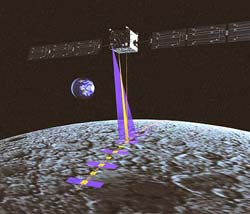This special field revolves around processes for modifying material properties (milling, cooling), composition (filtration, distillation) and type (oxidation, hydration).
Valuable information is available on a broad range of technologies including material separation, laser processes, measuring techniques and robot engineering in addition to testing methods and coating and materials analysis processes.

SMART-1, Europe’s first science spacecraft designed to orbit the Moon, has completed the first part of its journey by achieving its initial Earth orbit after a flawless launch during the night of 27/28 September.
The European Space Agency’s SMART-1 was one of three payloads on Ariane Flight 162. The generic Ariane-5 lifted off from the Guiana Space Centre, Europe’s spaceport at Kourou, French Guiana, at 2014 hrs local time (2314 hrs GMT) on 27 September (01:14 Central European Summer time o

Using laser light as tweezers and a scalpel, scientists from the National Institute of Standards and Technology (NIST) have demonstrated the use of artificial cells as nanovials for ultrasmall volume chemistry. The approach may be useful for faster, cheaper identification of new pharmaceuticals and for studying cellular-level processes. The researchers will report their results in the Sept. 30 edition of Langmuir.
The artificial cells, called liposomes, are tiny spherical containers that se

A new “smart blending” process developed by Clemson University researchers could change the way plastics are made and improve their performance. Early results published in August’s Polymer Engineering and Science have already drawn interest from European and United States plastics manufacturers.
Dave Zumbrunnen, who heads the Clemson research team, said smart blending could bring plastics production into the 21st century. “Most people would be surprised to learn that many plastics are n

A very efficient engine, plenty of room for instruments, accurate performance, good price. All these features characterise ESA’s SMART-1, due for launch during the night of 27-28 September.
SMART-1 is much smaller, cheaper and, in many ways, ’more powerful’ than conventional spacecraft. Its secret lies in several new technologies being tested on board, which will be essential for spacecraft of the future. But this space adventure is not only for engineers; scientists t

Many of Europe’s historic buildings, monuments and civil engineering structures are gradually decaying. Already weakened by age, they are damaged by earth tremors, pollution and traffic vibration. And this is more than just a cultural problem. Continual maintenance is extremely costly and obtrusive, not least because of its negative impact upon tourism and traffic.
Conventional rehabilitation methods using wooden or steel buttresses, tie rods and scaffolding supports dominate the landscape a

Fabric has been dyed by the same wasteful method for over 100 years. This involves chemical agents being added to a dye bath and thrown away afterwards. A new process developed by EUREKA project E! 2625 EUROENVIRON ECDVAT (ElectroChemical Dyeing with Vat dyes) replaces environmentally damaging chemical reducing agents with electrons.
According to Prof. Dr. Thomas Bechtold of the University of Innsbruck’s Textiles Department, the new process can be more easily controlled. Using the conventio